Contents
Are you considering a private (independent) school for your child's secondary education?
With more than 1,500 private senior schools across the UK — including around 500 boarding schools — it’s no surprise that knowing where to start can feel overwhelming. The good news: you don’t have to navigate it alone. We’ll guide you through the key things to know so you can make confident, informed choices.
Here’s what you’ll find in this guide:
The 100 highest-performing private schools in England in 2026
The difference between private and public schools
Fees and financial support available at the top 10 private schools
What are private schools?
Private schools — often called independent schools — are fee-paying. Unlike state schools, which are funded by the government and free to attend, independent schools ask families to pay fees directly. These are usually charged termly, meaning most parents make three payments across the academic year.
Private schools are independent from the state, which means you apply directly to each school. If you’re also considering state schools, you’ll still need to complete your local authority’s secondary school application form for those options.
Some private schools — especially the most competitive ones — are selective. Your child may need to meet specific academic criteria, such as passing an entrance exam, for their application to be considered.
Admissions timelines vary between schools. If you’re looking at 11+ entry into Year 7, most senior schools close registrations in October or November of Year 6, though some set earlier deadlines in the summer term of Year 5. Entrance exams usually take place in December or January.
Stay on track with every stage of the independent school admissions
Open days, entrance exams, bursary applications… there’s a lot to keep track of, and the deadlines can creep up fast.
That’s why we’ve created our parent checklist and timeline to provide a clear, term-by-term guide that shows you exactly when to take action in Year 5 and Year 6.
No more guesswork, no more last-minute panic, just a simple plan you can print, pin up, and follow confidently.
How much do private schools cost?
The fees for private senior schools varies depending on the school, where it is, and whether it offers boarding. As these schools receive more private funding, they are usually able to offer better facilities and a wider range of extracurricular activities (e.g. in sports, creative arts and outdoor pursuits) for their students.
The majority of private schools in England are able to offer financial assistance. The most common type of assistance, known as a bursary, is means-tested and usually available to children who pass the entrance process and whose parents would not otherwise be able to afford the school fees. According to the Independent Schools Council (ISC), which represents over 1,300 of the best-ranked UK and international schools, a total of £547 million per year is currently offered in fee assistance through bursaries.
Why are private schools in England sometimes called public schools?
As the terms private and public have entirely opposite meanings, it can be confusing when you hear some private schools being referred to as ‘public schools’.
In the UK, ‘public school’ is an archaic term used for an elite group of fee-paying schools. The term first emerged in the 18th century when a small group of well-established boys’ schools distinguished themselves from the spread of grammar schools (which were free) by charging fees. These schools were Eton College, Shrewsbury School, Harrow School, Charterhouse School, Rugby School, Westminster School and Winchester College.
‘Public school’ is now considered an outdated term in the UK, with fee-paying schools now typically referred to as ‘private schools’ or 'independent schools’.
What is the average class size in UK private schools?
UK private schools are renowned for having smaller class sizes than their state school counterparts. While state schools will often have around 30-32 pupils in a class, private schools have a much lower pupil-to-teacher ratio.
In Key Stage 3 (Year 7 to 9), there are around 20 (normally no more than 25) pupils per class in UK private schools. As pupils move from year to year, class sizes tend to become smaller as a result of ‘streaming’ (setting classes based on academic ability) and more subject choices to choose from at GCSE and A level. Sixth form classes are typically much smaller, with around 8 to 15 students in a class.
The top 100 private schools in UK in 2026
The following schools were ranked the best in the country by The Times based on their A level (or equivalent) and GCSE results in 2025.
1. St Paul’s School (London)
A level results: 98.2% A*–B
GCSE results: 97.6% A*/A/9/8/7
Entry gender: boys
2. Brighton College (Brighton)
A level results: 97.9% A*–B
GCSE results: 98% A*/A/9/8/7
Entry gender: mixed
3. North London Collegiate School (London)
A level results: 96.6% A*–B
GCSE results: 99.2% A*/A/9/8/7
Entry gender: girls
4. Godolphin and Latymer School (London)
A level results: 97.5% A*–B
GCSE results: 96.9% A*/A/9/8/7
Entry gender: girls
5. Guildford High School (Guildford)
A level results: 97.3% A*–B
GCSE results: 96.7% A*/A/9/8/7
Entry gender: girls
6. St Paul’s Girls’ School (London)
A level results: 95.6% A*–B
GCSE results: 99.5% A*/A/9/8/7
Entry gender: girls
7. King’s College School, Wimbledon (London)
A level results: 96.2% A*–B
GCSE results: 98.2% A*/A/9/8/7
Entry gender: boys, mixed sixth form
8. Westminster School (London)
A level results: 96.3% A*–B
GCSE results: 97.6% A*/A/9/8/7
Entry gender: boys, mixed sixth form
9. City of London School for Girls (London)
A level results: 95.7% A*–B
GCSE results: 95.4% A*/A/9/8/7
Entry gender: girls
10. Latymer Upper School (London)
A level results: 95.1% A*–B
GCSE results: 96.5% A*/A/9/8/7
Entry gender: mixed
11. King Edward VI High School for Girls (Birmingham)
A level results: 94.9% A*–B
GCSE results: 96.6% A*/A/9/8/7
Entry gender: girls
12. Lady Eleanor Holles (London)
A level results: 95.9% A*–B
GCSE results: 93.6% A*/A/9/8/7
Entry gender: girls
13. Alleyn’s School (London)
A level results: 94.7% A*–B
GCSE results: 94.8% A*/A/9/8/7
Entry gender: mixed
14. Eton College (Windsor)
A level results: 95% A*–B
GCSE results: 94% A*/A/9/8/7
Entry gender: boys
15. Sevenoaks School (Sevenoaks)
A level results: 97.4% A*–B
GCSE results: 88.7% A*/A/9/8/7
Entry gender: mixed
16. South Hampstead High School GDST (London)
A level results: 95.2% A*–B
GCSE results: 92.2% A*/A/9/8/7
Entry gender: girls
17. City of London School (London)
A level results: 93.2% A*–B
GCSE results: 95.5% A*/A/9/8/7
Entry gender: boys
18. Wycombe Abbey (High Wycombe)
A level results: 92.4% A*–B
GCSE results: 96.7% A*/A/9/8/7
Entry gender: girls
19. Highgate School (London)
A level results: 92.7% A*–B
GCSE results: 95.7% A*/A/9/8/7
Entry gender: mixed
20. Magdalen College School (Oxford)
A level results: 93.2% A*–B
GCSE results: 94.1% A*/A/9/8/7
Entry gender: boys, mixed sixth form
21. Queen Ethelburga’s College (York)
A level results: 94.5% A*–B
GCSE results: 90.3% A*/A/9/8/7
Entry gender: mixed
22. Royal Grammar School, Guildford (Guildford)
A level results: 95.2% A*–B
GCSE results: 88.6% A*/A/9/8/7
Entry gender: boys
23=. Putney High School GDST (London)
A level results: 93.4% A*–B
GCSE results: 91.8% A*/A/9/8/7
Entry gender: girls
23=. Hampton School (London)
A level results: 91.5% A*–B
GCSE results: 95.8% A*/A/9/8/7
Entry gender: boys
25. University College School (London)
A level results: 93.6% A*–B
GCSE results: 91.3% A*/A/9/8/7
Entry gender: boys, mixed sixth form
26=. Winchester College (Winchester)
A level results: 92.4% A*–B
GCSE results: 93.5% A*/A/9/8/7
Entry gender: boys, mixed sixth form
26=. The Perse School (Cambridge)
A level results: 93.9% A*–B
GCSE results: 90.4% A*/A/9/8/7
Entry gender: mixed
28. Tonbridge School (Tonbridge)
A level results: 92.5% A*–B
GCSE results: 92.6% A*/A/9/8/7
Entry gender: boys
29. Reigate Grammar School (Reigate)
A level results: 93.9% A*–B
GCSE results: 89.7% A*/A/9/8/7
Entry gender: mixed
30. Kingston Grammar School (Kingston upon Thames)
A level results: 92.7% A*–B
GCSE results: 91.6% A*/A/9/8/7
Entry gender: mixed
31. Concord College (Shrewsbury)
A level results: 95.3% A*–B
GCSE results: 86.2% A*/A/9/8/7
Entry gender: mixed
32. Trinity School, Croydon (Croydon)
A level results: 95% A*–B
GCSE results: 86.1% A*/A/9/8/7
Entry gender: boys, mixed sixth form
33. James Allen’s Girls’ School (London)
A level results: 92.7% A*–B
GCSE results: 90.7% A*/A/9/8/7
Entry gender: girls
34. Notting Hill and Ealing High School GDST (London)
A level results: 91.4% A*–B
GCSE results: 93.1% A*/A/9/8/7
Entry gender: girls
35. Withington Girls’ School (Manchester)
A level results: 91.3% A*–B
GCSE results: 92.9% A*/A/9/8/7
Entry gender: girls
36. Wimbledon High School GDST (London)
A level results: 94.6% A*–B
GCSE results: 85.9% A*/A/9/8/7
Entry gender: girls
37. Bancroft’s (Woodford Green)
A level results: 93.2% A*–B
GCSE results: 88.3% A*/A/9/8/7
Entry gender: boys
38=. Caterham School (Caterham)
A level results: 91.4% A*–B
GCSE results: 91.5% A*/A/9/8/7
Entry gender: mixed
38=. The Manchester Grammar School (Manchester)
A level results: 93% A*–B
GCSE results: 88.2% A*/A/9/8/7
Entry gender: boys
40. Cardiff Sixth Form College (Cardiff)
A level results: 99.6% A*–B
GCSE results: 74.8% A*/A/9/8/7
Entry gender: boys
41. King Edward’s School, Birmingham (Birmingham)
A level results: 94.8% A*–B
GCSE results: 83.8% A*/A/9/8/7
Entry gender: boys
42. Emanuel School (London)
A level results: 91.3% A*–B
GCSE results: 90.9% A*/A/9/8/7
Entry gender: mixed
43=. Oxford High School GDST (Oxford)
A level results: 89.3% A*–B
GCSE results: 93.6% A*/A/9/8/7
Entry gender: girls
43=. Eltham College (London)
A level results: 91.9% A*–B
GCSE results: 88.5% A*/A/9/8/7
Entry gender: boys, mixed sixth form
45. Channing School (London)
A level results: 95.1% A*–B
GCSE results: 81.7% A*/A/9/8/7
Entry gender: girls
46. Dulwich College (London)
A level results: 89.1% A*–B
GCSE results: 93.5% A*/A/9/8/7
Entry gender: boys
47. Colfe’s School (London)
A level results: 95.3% A*–B
GCSE results: 80.1% A*/A/9/8/7
Entry gender: mixed
48. Wellington College (Crowthorne)
A level results: 91.6% A*–B
GCSE results: 86.7% A*/A/9/8/7
Entry gender: mixed
49. Nottingham High School (Nottingham)
A level results: 92.4% A*–B
GCSE results: 84.9% A*/A/9/8/7
Entry gender: mixed
50. Surbiton High School (Kingston upon Thames)
A level results: 91.8% A*–B
GCSE results: 85.5% A*/A/9/8/7
Entry gender: girls
51. St Albans High School for Girls (St Albans)
A level results: 92% A*–B
GCSE results: 85% A*/A/9/8/7
Entry gender: girls
52. Epsom College (Epsom)
A level results: 90.6% A*–B
GCSE results: 87.1% A*/A/9/8/7
Entry gender: mixed
53. Whitgift School (South Croydon)
A level results: 90.1% A*–B
GCSE results: 87.2% A*/A/9/8/7
Entry gender: boys
54. St Helen and St Katharine (Abingdon)
A level results: 87.5% A*–B
GCSE results: 92.1% A*/A/9/8/7
Entry gender: girls
55. Merchant Taylors’ School, Northwood (London)
A level results: 89.3% A*–B
GCSE results: 88.3% A*/A/9/8/7
Entry gender: boys
56. Westbourne School (Penarth)
A level results: 96.5% A*–B
GCSE results: 73.1% A*/A/9/8/7
Entry gender: mixed
57. City of London Freemen’s School (Ashtead)
A level results: 92.2% A*–B
GCSE results: 81.5% A*/A/9/8/7
Entry gender: mixed
58. St Michael’s School (Llanelli)
A level results: 93.5% A*–B
GCSE results: 78.7% A*/A/9/8/7
Entry gender: mixed
59. Francis Holland School, Sloane Square (London)
A level results: 89% A*–B
GCSE results: 87% A*/A/9/8/7
Entry gender: girls
60. Abingdon School (Abingdon)
A level results: 88.9% A*–B
GCSE results: 87.1% A*/A/9/8/7
Entry gender: boys
61. St Mary’s School Ascot (Ascot)
A level results: 84.7% A*–B
GCSE results: 94.1% A*/A/9/8/7
Entry gender: girls
62. Cheltenham Ladies’ College (Cheltenham)
A level results: 87.3% A*–B
GCSE results: 87.6% A*/A/9/8/7
Entry gender: girls
63. Harrow School (Harrow on the Hill)
A level results: 88.6% A*–B
GCSE results: 84.3% A*/A/9/8/7
Entry gender: boys
64. St Catherine’s, Bramley (Guildford)
A level results: 90.8% A*–B
GCSE results: 79.6% A*/A/9/8/7
Entry gender: girls
65. St Swithun’s School (Winchester)
A level results: 91.8% A*–B
GCSE results: 77.4% A*/A/9/8/7
Entry gender: girls
66. Radley College (Abingdon)
A level results: 86.6% A*–B
GCSE results: 86.5% A*/A/9/8/7
Entry gender: boys
67. The Leys (Cambridge)
A level results: 85.7% A*–B
GCSE results: 86.1% A*/A/9/8/7
Entry gender: mixed
68. Sir William Perkins’s School (Chertsey)
A level results: 86.1% A*–B
GCSE results: 85% A*/A/9/8/7
Entry gender: girls
69. Sheffield Girls’ GDST (Sheffield)
A level results: 87.9% A*–B
GCSE results: 80.2% A*/A/9/8/7
Entry gender: girls
70. King Edward’s School, Bath (Bath)
A level results: 89.7% A*–B
GCSE results: 76.6% A*/A/9/8/7
Entry gender: boys
71. St Dunstan’s College (London)
A level results: 89.5% A*–B
GCSE results: 76.7% A*/A/9/8/7
Entry gender: mixed
72. Ibstock Place School (London)
A level results: 86% A*–B
GCSE results: 83.4% A*/A/9/8/7
Entry gender: mixed
73=. Churcher’s College (Petersfield)
A level results: 90.7% A*–B
GCSE results: 73.6% A*/A/9/8/7
Entry gender: mixed
73=. Hurstpierpoint College (Hassocks)
A level results: 88% A*–B
GCSE results: 79% A*/A/9/8/7
Entry gender: mixed
75. St John’s College, Cardiff (Cardiff)
A level results: 87.3% A*–B
GCSE results: 80.2% A*/A/9/8/7
Entry gender: mixed
76. Benenden School (Cranbrook)
A level results: 87.9% A*–B
GCSE results: 78.2% A*/A/9/8/7
Entry gender: girls
77=. Haileybury (Hertford)
A level results: 85.8% A*–B
GCSE results: 82.4% A*/A/9/8/7
Entry gender: mixed
77=. Harrodian (London)
A level results: 88.4% A*–B
GCSE results: 77.1% A*/A/9/8/7
Entry gender: mixed
79. The King’s School, Chester (Chester)
A level results: 84.8% A*–B
GCSE results: 83.6% A*/A/9/8/7
Entry gender: mixed
80. Queen’s College, London (London)
A level results: 86.2% A*–B
GCSE results: 80.8% A*/A/9/8/7
Entry gender: girls
81=. Francis Holland School, Regent’s Park (London)
A level results: 87% A*–B
GCSE results: 79% A*/A/9/8/7
Entry gender: girls
81=. Royal Grammar School, Newcastle (Newcastle upon Tyne)
A level results: 86.3% A*–B
GCSE results: 80.3% A*/A/9/8/7
Entry gender: mixed
83. Oundle School (Peterborough)
A level results: 87.5% A*–B
GCSE results: 77.6% A*/A/9/8/7
Entry gender: mixed
84. St Helen’s School, Northwood (London)
A level results: 85.9% A*–B
GCSE results: 80.4% A*/A/9/8/7
Entry gender: girls
85. St Augustine’s Priory (London)
A level results: 93.5% A*–B
GCSE results: 64.2% A*/A/9/8/7
Entry gender: girls
86. Redmaids’ High School (Bristol)
A level results: 88.6% A*–B
GCSE results: 73.1% A*/A/9/8/7
Entry gender: girls
87. St Albans School (St Albans)
A level results: 84.6% A*–B
GCSE results: 80.4% A*/A/9/8/7
Entry gender: boys, mixed sixth form
88. The Cathedral School, Llandaff (Cardiff)
A level results: 89.8% A*–B
GCSE results: 69.9% A*/A/9/8/7
Entry gender: mixed
89=. Reading Blue Coat (Sonning-on-Thames)
A level results: 83.4% A*–B
GCSE results: 81.9% A*/A/9/8/7
Entry gender: boys, mixed sixth form
89=. Immanuel College (Bushey)
A level results: 88.4% A*–B
GCSE results: 71.9% A*/A/9/8/7
Entry gender: mixed
91. Manchester High School for Girls (Manchester)
A level results: 85.9% A*–B
GCSE results: 76.9% A*/A/9/8/7
Entry gender: girls
92. The Abbey (Reading)
A level results: 83.9% A*–B
GCSE results: 80.8% A*/A/9/8/7
Entry gender: girls
93. Woldingham School (Caterham)
A level results: 88.8% A*–B
GCSE results: 70.4% A*/A/9/8/7
Entry gender: girls
94=. Solihull School (Solihull)
A level results: 84.4% A*–B
GCSE results: 78.8% A*/A/9/8/7
Entry gender: mixed
94=. The Maynard School (Exeter)
A level results: 86.1% A*–B
GCSE results: 75.4% A*/A/9/8/7
Entry gender: girls
96. Downe House (Thatcham)
A level results: 83% A*–B
GCSE results: 81% A*/A/9/8/7
Entry gender: girls
97. Bedford School (Bedford)
A level results: 86.3% A*–B
GCSE results: 74.1% A*/A/9/8/7
Entry gender: boys
98. The Grammar School at Leeds (Leeds)
A level results: 87.4% A*–B
GCSE results: 71.1% A*/A/9/8/7
Entry gender: mixed
99. Leicester Grammar School (Leicester)
A level results: 85.8% A*–B
GCSE results: 74.2% A*/A/9/8/7
Entry gender: mixed
100. Croydon High School GDST (South Croydon)
A level results: 84% A*–B
GCSE results: 77.5% A*/A/9/8/7
Entry gender: girls
Find a top private school near you
The top 10 private schools in detail
1. St Paul's School
 © stpaulsschool.org.uk
© stpaulsschool.org.uk
St Paul’s School is a boys’ independent day and boarding school located on a 43-acre site in Barnes, West London. It was founded in 1509 by John Colet, Dean of St Paul’s Cathedral. Boys at St Paul’s School are known as ‘Paulines’.
In 2025, it sent 38 boys to Oxford and Cambridge universities and 33 boys to universities in North America.
St Paul's School fees
St Paul's School fees are £11,949 per term for day pupils, and £17,981 for boarders. The school offers a bursary programme (known as the Founder's Awards) for lower-income families ranging from 5-100% of fees. St Paul’s School also offers academic scholarships and sports awards.
2. Brighton College
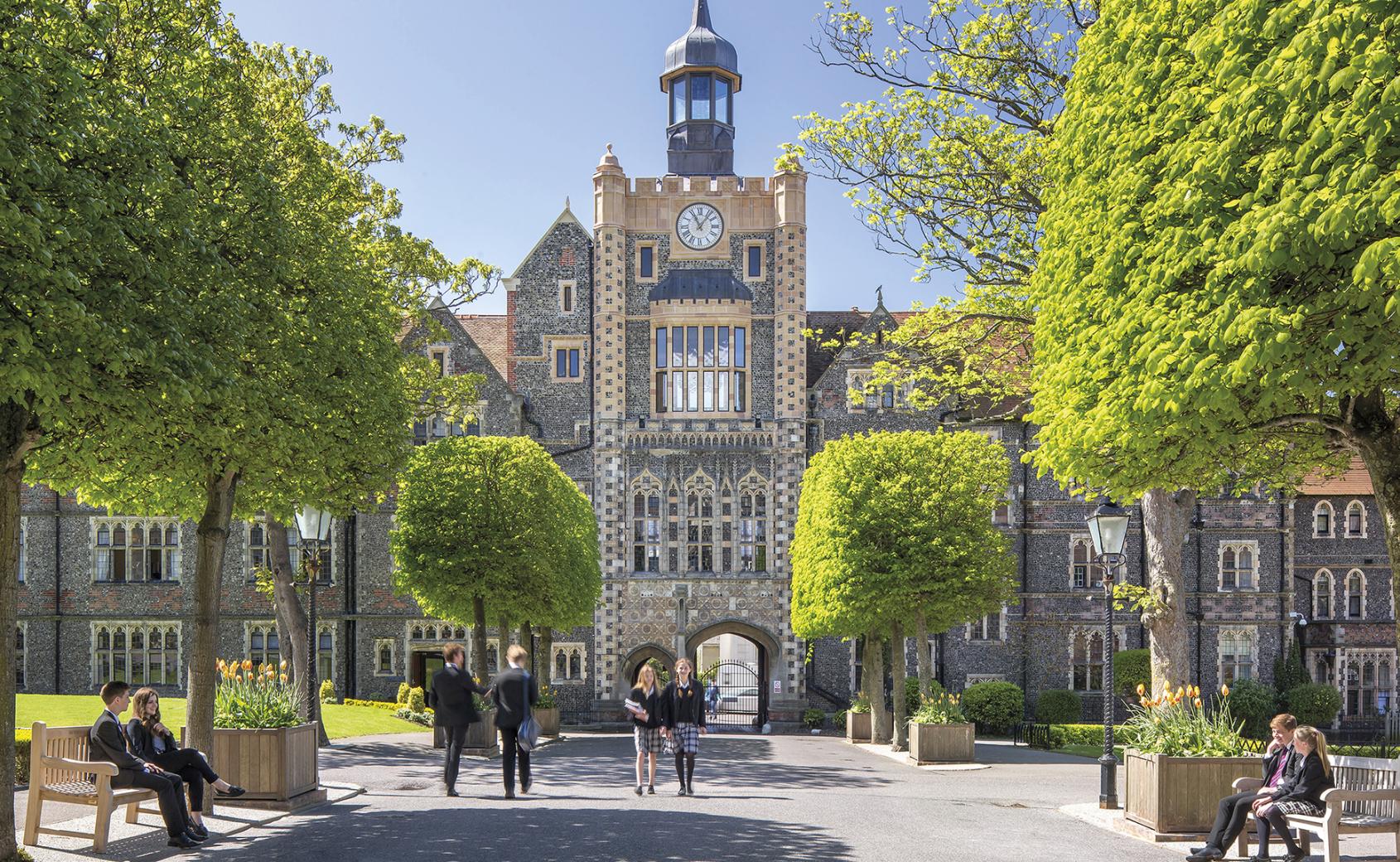 © brightoncollege.org.uk
© brightoncollege.org.uk
Brighton College is a prestigious co-educational day and boarding school located in Brighton, East Sussex. Founded in 1845, it has a long-standing reputation for academic excellence and innovation, making it one of the top independent schools in the UK.
The school was named The Sunday Times Parent Power School of the Decade, and in 2025 was awarded Independent Boarding School of the Year, Independent School of the Year for A-levels and Independent School of the Year for Academic Excellence in the Southeast.
Brighton College fees
The current fees at Brighton College range from £8,000-£10,970 per term for day pupils, including lunch and £15,290-£19,140 per term for boarders.
Brighton College offers a range of scholarships and bursaries to support eligible families. These include academic, music, and sports scholarships, as well as means-tested bursaries that can cover up to 100% of tuition fees.
3. North London Collegiate School
 © tatler.com
© tatler.com
North London Collegiate School is an independent day school for girls aged 4–18. It was founded in 1850 by Frances Buss – a pioneer in girls’ education – as the first girls’ school in the UK to offer girls the same educational opportunities as boys. It occupies a Georgian mansion on a 30-acre site in Edgware, North West London.
North London Collegiate School fees
The fees at North London Collegiate School are £9,917 per term. Means-tested bursaries of up to 100% fee remission are available for 11 plus and 16 plus candidates.
Scholarships are available at the school, including the Handel music scholarship and the Sophie Bryant scholarship which are unique to the school.
4. Godolphin and Latymer
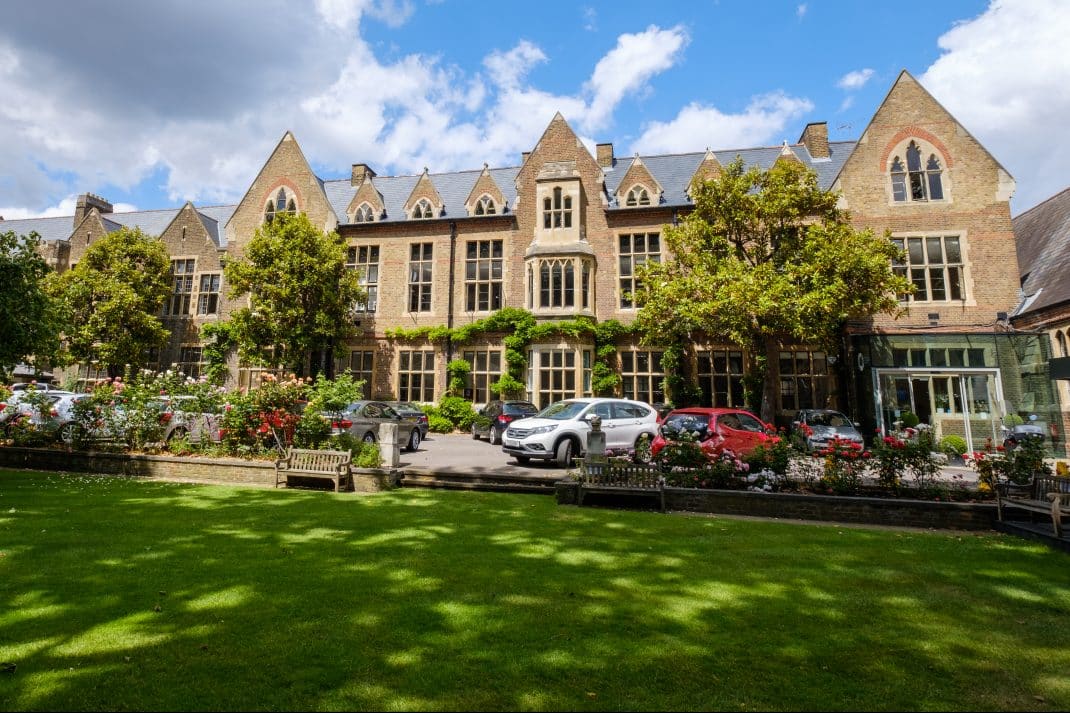 © godolphinandlatymer.com
© godolphinandlatymer.com
Godolphin and Latymer School is an independent day school for girls, located in Hammersmith, West London. Established in 1905, the school has a longstanding reputation for academic excellence and offers a broad curriculum, including both A-levels and the International Baccalaureate (IB) in the Sixth Form.
Godolphin and Latymer School fees
The termly tuition fee at Godolphin and Latymer School ranges from £11,226-£11,698. The school provides means-tested bursaries ranging from 10% to 100% of tuition fees to eligible families. Additionally, music and art scholarships are available at 11+ and 16+ entry, offering up to 30% of school fees.
5. Guildford High School
 © bellsure.co.uk
© bellsure.co.uk
Founded in 1888, Guildford High School is an independent day school educating approximately 1,000 girls aged 4–18. The school offers an extensive co-curricular programme, with more than 70 clubs running each week, and has placed a strong emphasis on sustainability in recent years. In 2023, it was awarded the Eco-Schools Green Flag with Distinction in recognition of its environmental initiatives.
Guildford High School fees
Guildford High School’s fees are £8,663 per term. The school offers a sibling discount of 5% (and 10% for subsequent daughters) and means-tested bursaries to eligible families. Scholarships are available to internal and external candidates and typically provide between 5% and 10% fee remission.
6. St Paul's Girls' School
 © spgs.org
© spgs.org
St Paul’s Girls’ School, located in Hammersmith, West London, is often top of the list in The Sunday Times Parent Power’s top independent schools. The girls’ day school was founded in 1904 to complement St Paul’s School (the boys’ counterpart), which was founded in the 16th century.
Students are known as ‘Paulinas’. There are approximately 20 students per class in the Lower School at St Paul’s Girls’ School.
St Paul's Girls' School fees
St Paul's Girls' school fees range from £12,414-£13,409 per term, which includes lunch. The school offers music scholarships for 11 plus applicants and has a means-tested bursary programme available to families with a total gross household income of less than £140k.
7. King's College School Wimbledon
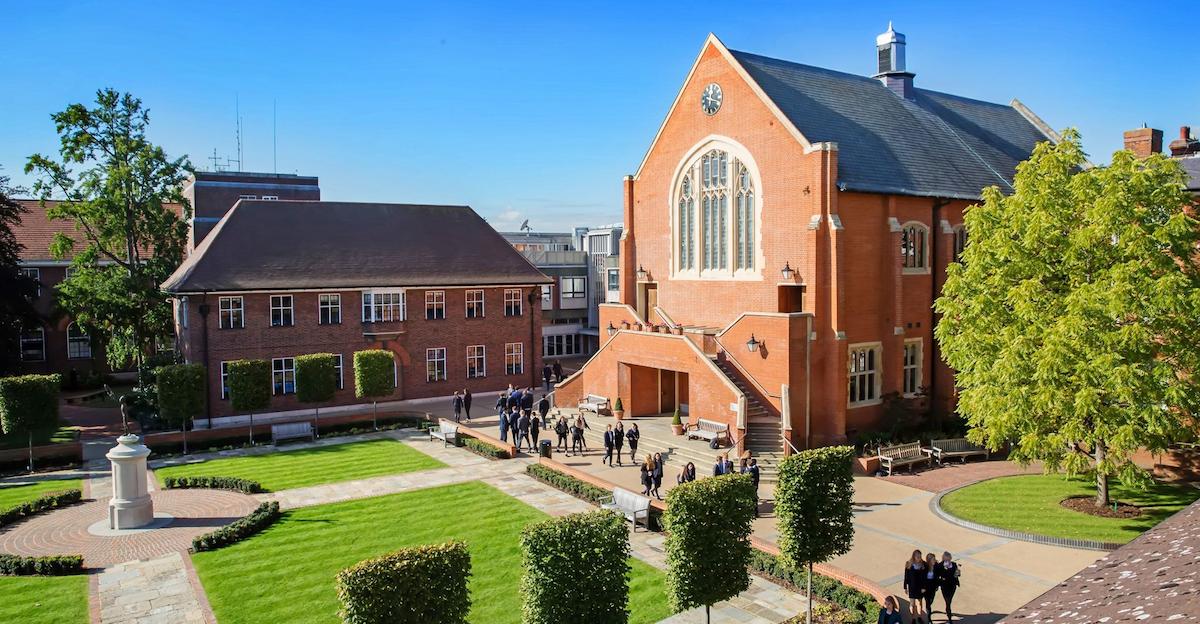 © kcs.org.uk
© kcs.org.uk
King’s College School Wimbledon is a prestigious boys’ day school situated on the edge of Wimbledon Common in South West London. Girls are accepted into the sixth form. The school was founded by royal charter in 1829 as the junior department of King’s College London on the Strand, before moving to Wimbledon in 1897.
King's College School Wimbledon fees
King's College School fees range from £10,410-£11,404 per term. The school offers entrance bursaries of up to 100% tuition fees to eligible families as well as academic, music and sports scholarships.
8. Westminster School
 © tatler.com
© tatler.com
Westminster School is an independent day and boarding school for boys (and girls in the sixth form) located in Little Dean’s Yard in the precincts of Westminster Abbey, City of Westminster. The school has a long-established reputation for academic excellence, and a significant proportion of its sixth-form leavers progress to highly selective universities, including Oxford and Cambridge.
Westminster School fees
Westminster school fees range from £15,451-£16,650 per term for day pupils, and are £21,992 per term for boarders. A bursary programme is in place, awards may vary from 5% to a 100% fee remission. Academic and music scholarships are also available, including awards for specialist talents such as the Henry Purcell organ scholarship.
9. City of London School for Girls
 © tatler.com
© tatler.com
City of London School for Girls is an independent day school for girls aged 7–18 in the heart of Central London. The school describes itself as 'intellectually edgy, unassuming and unpretentious'. A unique coaching programme supports girls to become confident young women by developing inner strength, social and emotional intelligence, positivity and integrity.
City of London School for Girls fees
City of London School for Girls school fees are £10,082 per term. A capped number of means-tested bursaries (usually 12–15 at 11+ entry) are available. The school also offers 11+ music scholarships worth up to 10% fee remission and there are scholarships available in music, drama, art and sport at 16+.
10. Latymer Upper School
 © latymer-upper.org
© latymer-upper.org
Latymer Upper School is one of London’s leading private day schools for boys and girls aged 7–18. It combines high-quality academic provision with a broad co-curricular programme, including music, drama, sport and the arts, and fosters a well-rounded, socially aware community.
In 2025, a record-breaking 95% of A-level results were A*-B and 84% of sixth-formers who applied to university were accepted onto their first-choice course.
Latymer Upper School fees
Latymer Upper School fees are £10,365 per term. Bursaries are available at main entry points of 11+ and 16+ and depending on your family’s financial circumstances they can cover between 25% to 100% of fees.
Scholarships are available. At 11+ the school offers music scholarships while at 16+ candidates can apply for music, art, drama or sport. scholarships at both 11+ and 16+ are awarded either as a percentage reduction of fees or a one-time award.
Top tips for applying to independent schools
Preparing for independent school entrance exams doesn’t need to feel daunting. With the right support, your child can feel confident and ready for the exam process.
Here are our top tips to do just that:
1. Get familiar with the 11+ exam format
Many independent school entrance exams test four key areas: English, maths, verbal reasoning, and non-verbal reasoning. These aren’t always taught explicitly in school, so it’s important your child gets used to the types of questions they’ll see in the test.
How Atom helps: Atom’s learning platform mirrors independent school exams, with thousands of interactive questions in all four subjects. Learning content is adaptive, so your child will always work at the right level to keep them challenged without losing motivation.
2. Strengthen core knowledge
A strong grasp of Key Stage 2 English and maths is essential. Make sure your child is confident with grammar, spelling, punctuation, arithmetic and problem-solving before focusing on exam technique.
How Atom helps: Atom covers the entire Key Stage 2 curriculum in English and maths, plus verbal and non-verbal reasoning (which aren't taught on the national curriculum). As your child learns, they’ll earn rewards and progress through fun, engaging learning journeys — all in one platform.
3. Practise speed and accuracy
Your child will need to answer questions accurately and under timed conditions. Regular practice will help them build speed and avoid common mistakes.
How Atom helps: With Atom, your child can access unlimited custom mock tests. You'll get instant results and insights into their strengths and areas to improve.
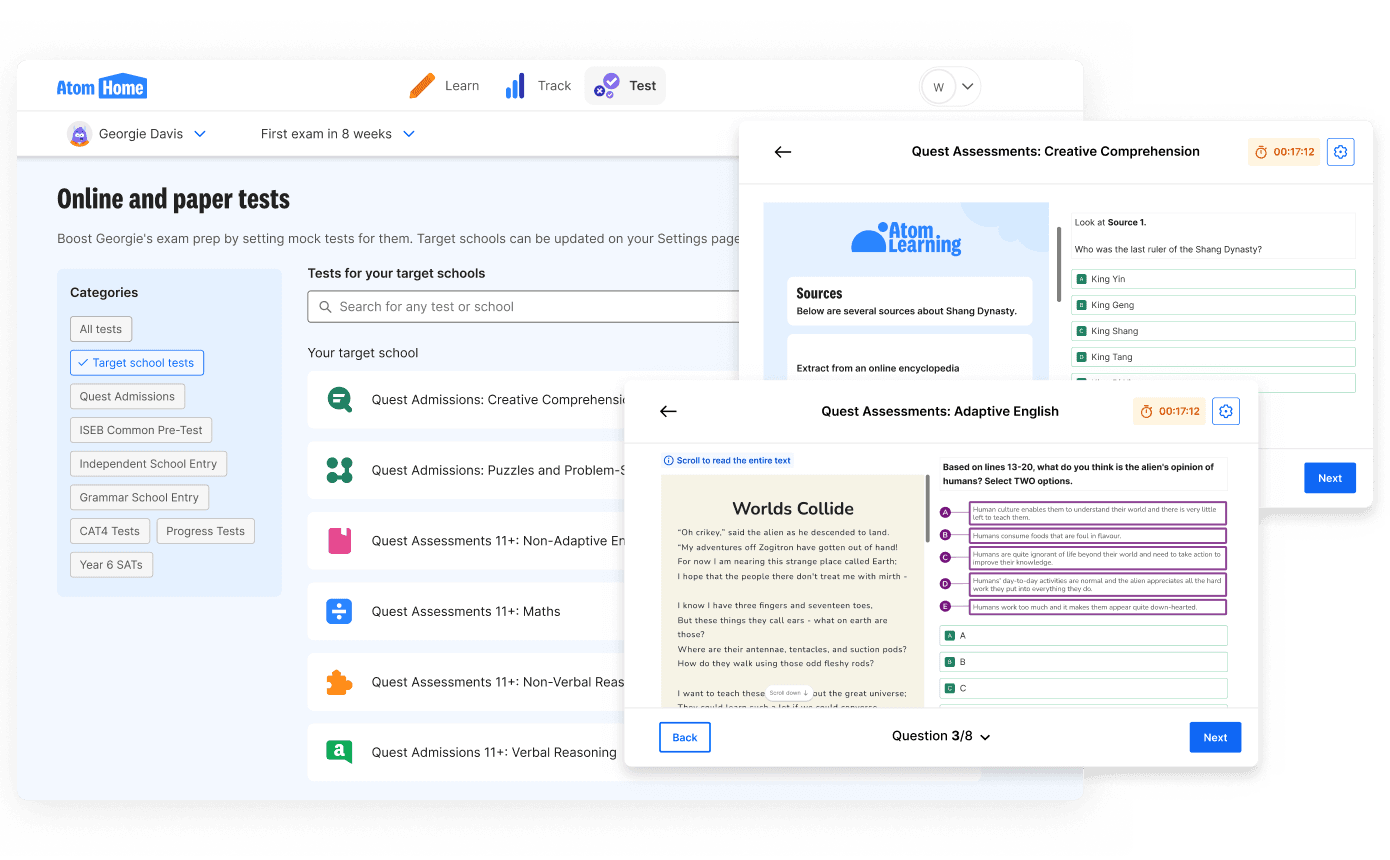
4. Keep a regular routine
Consistent, manageable study sessions work better than last-minute cramming. Aim for short bursts of focused learning, with regular breaks to avoid fatigue and keep motivation high.
How Atom helps: Atom creates a personalised weekly learning schedule based on your child’s progress. This helps them stay on track without feeling overwhelmed.
5. Practise interview technique
Many independent schools hold interviews to provide a better understanding of whether the school is right for your child and vice versa. Practising interview techniques at home will build confidence ahead of the big day.
How Atom helps: Find out more about preparing your child in our ultimate guide to interviews, including question examples and more.
6. Track progress over time
Knowing how your child is progressing can give you peace of mind — and help you target revision more effectively. It’s also a great way to celebrate the effort they’re putting in.
How Atom helps: You’ll get access to a real-time parent dashboard, where you can see how your child is performing across all subjects. No need to guess what’s going well or what needs more attention.
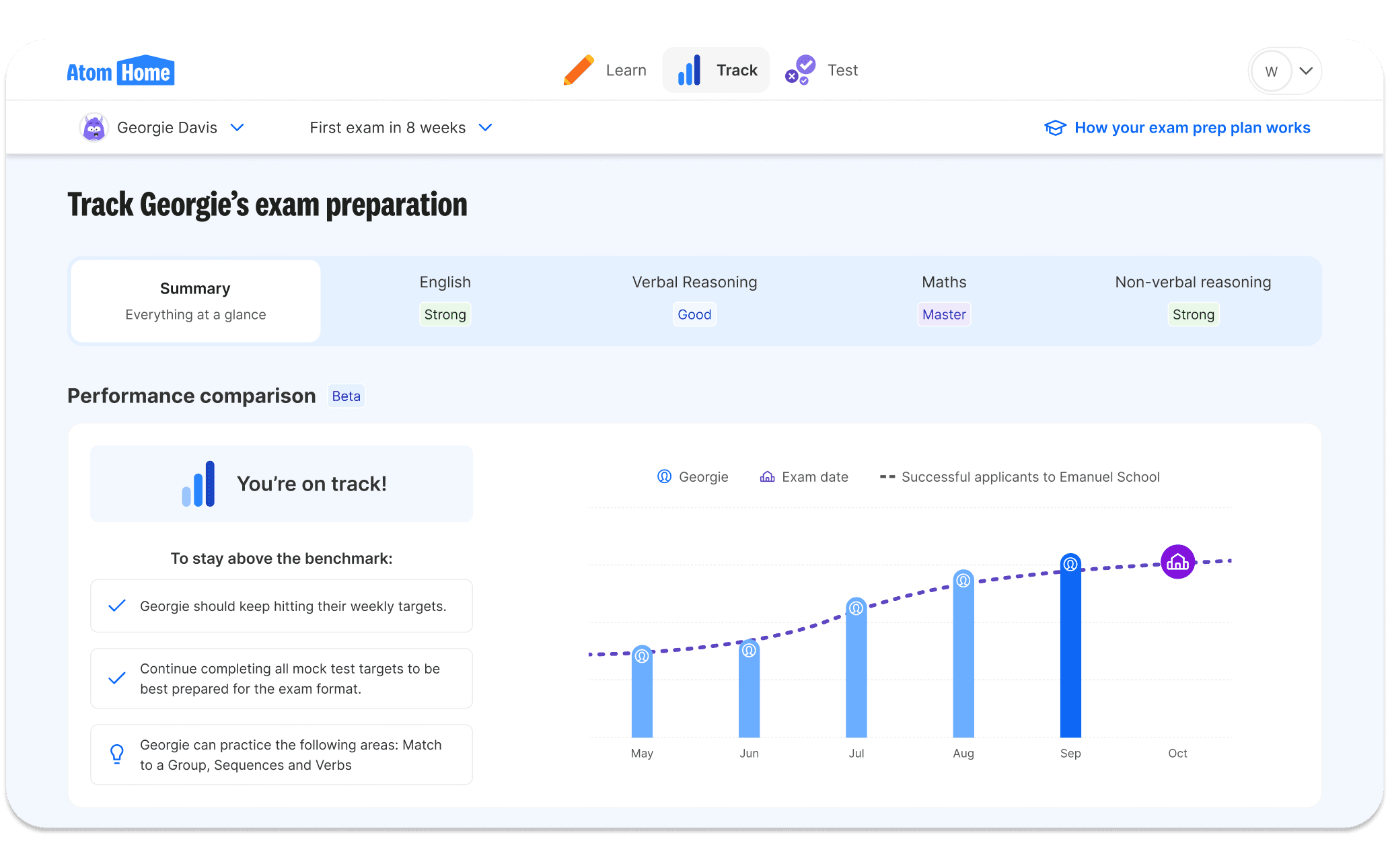
7. Get the right support
You don’t need to rely on expensive tutors to prepare for independent school exams. With the right tools, your child can prepare effectively and independently — while building long-term skills and confidence.
How Atom helps: Atom combines high-quality learning resources with smart technology to deliver a tutor-quality experience at home. And if you ever need help, our Education Support team is here to guide you.
Ready to ace independent school exams?
Join 100,000+ families who trust Atom to help their children excel in Key Stage 2 and beyond. Endorsed by schools, loved by parents.
Contents

